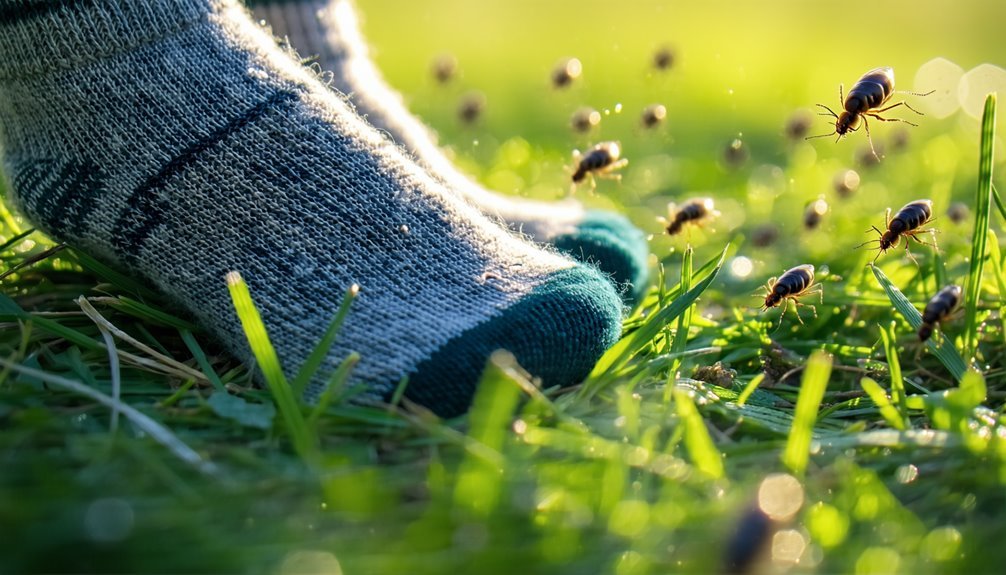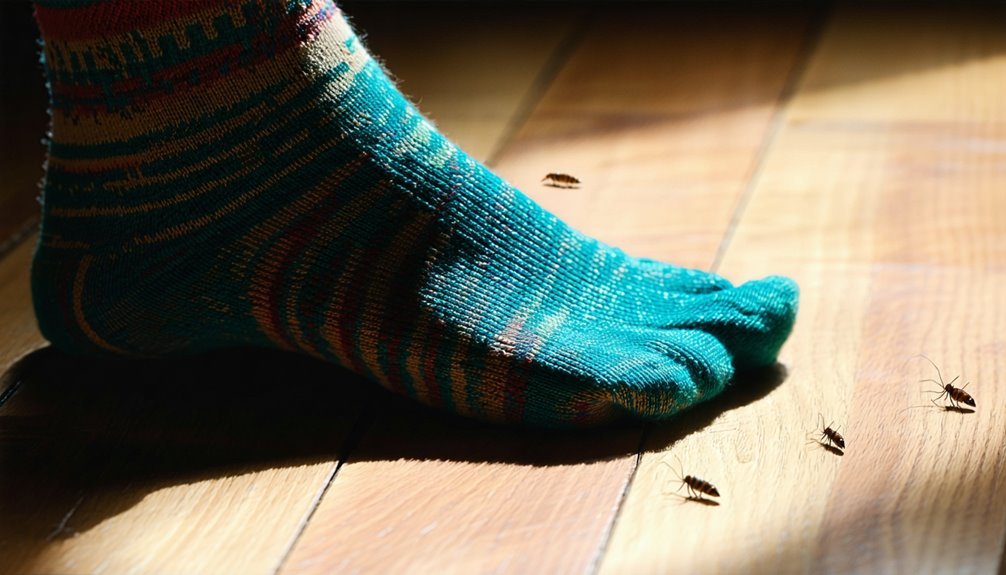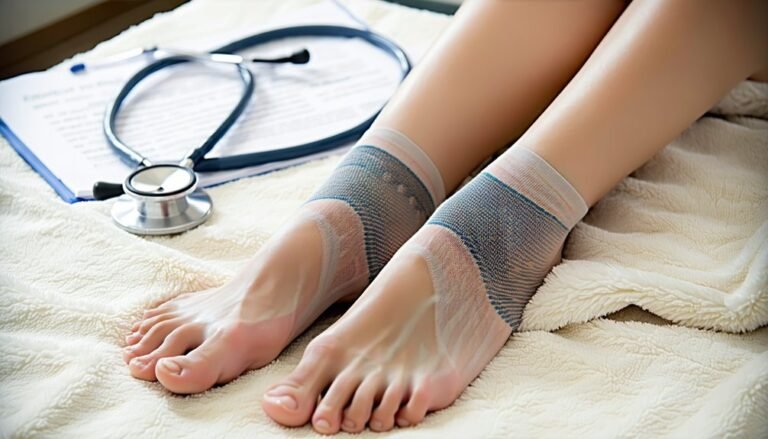Can Fleas Bite Through Socks?
Fleas can bite through socks, but their ability is influenced by the sock's material and thickness. Thicker and tightly woven fabrics, like wool or synthetic blends, provide a significant barrier, reducing the likelihood of penetration. Breathable yet snug-fitting socks minimize gaps, deterring flea access. Cotton socks, with their looser weave, offer less protection. To optimize protection against fleas, selecting socks with dense weaves can greatly reduce exposure. Learn how varying sock types can enhance your defense.
Understanding Flea Anatomy

Fleas, those tiny yet resilient parasites, possess a fascinating and complex anatomy that enables their survival and proliferation. You'll find that flea anatomy is optimized for jumping, with hind legs that act like powerful levers, allowing them to leap up to 200 times their body length. This adaptability is vital for traversing environments and locating hosts. Their bodies are laterally compressed, facilitating movement through fur or feathers without obstruction. Regarding flea physiology, their exoskeletons provide protection and flexibility, essential for withstanding pressure and enabling agility. Fleas also have specialized mouthparts designed for piercing skin and drawing blood, though we'll explore deeper into their mechanics later. Understanding these attributes helps guarantee effective prevention and control, safeguarding you from their potential threats.
The Mechanics of Flea Bites
Though often underestimated, the mechanics of flea bites are a marvel of evolutionary adaptation. Fleas possess specialized mouthparts structured to penetrate the skin efficiently, inducing flea bite sensations characterized by discomfort and itching. These sensations arise from saliva injected during feeding, containing anticoagulants that facilitate blood flow. Understanding this process is vital for effective flea bite prevention. Fleas can leap remarkable distances, accessing hosts with ease. Their bites are not just a nuisance but a potential vector for diseases. To guarantee safety, adopting preventive measures such as regular pet treatments and maintaining a clean environment is essential. By disrupting the flea lifecycle, you can greatly reduce exposure. Knowledge of these mechanics empowers you to protect yourself and your loved ones effectively.
Sock Material and Thickness
Understanding the mechanics of flea bites underscores the importance of protective barriers, such as socks, which can play a critical role in reducing flea exposure. Your choice of sock material and thickness can greatly impact your defense against these pests. Here's what you should consider:
- Sock Durability: Opt for tightly woven fabrics like wool or synthetic blends that resist penetration.
- Fabric Breathability: Choose materials that balance breathability and thickness to prevent overheating while maintaining protective integrity.
- Thickness: Thicker socks provide an additional physical barrier, reducing the likelihood of flea bites reaching your skin.
- Elasticity: Verify socks fit snugly to minimize gaps where fleas might infiltrate.
Prioritize these factors to enhance your protection, guaranteeing comfort without compromising your safety.
Flea Behavior and Movement

You should consider the flea's exceptional jumping capabilities, as they can leap up to 150 times their body length, a feat enabled by the resilience of their leg structures. This ability allows them to effectively navigate through various fabric types, including socks, by utilizing strategic jumps to avoid obstacles. Research indicates that the flea's adaptive movement not only aids in evading predators but also in efficiently seeking hosts within textile environments.
Flea Jumping Capabilities
A flea's jumping capabilities are nothing short of extraordinary, allowing it to leap distances over 200 times its own body length. This flea agility is due to specialized anatomical structures like the resilin pad, which stores energy and releases it rapidly. To understand the implications, consider these factors:
- Distance: A flea can jump approximately 8 inches vertically and 13 inches horizontally.
- Speed: It accelerates at nearly 100 times the force of gravity, enabling quick escapes.
- Precision: Fleas use visual and tactile cues to land on hosts accurately.
- Energy Efficiency: Resilin allows multiple jumps with minimal fatigue.
Recognizing these capabilities aids in implementing effective preventative measures, ensuring your environment remains free from infestations. Stay informed and proactive in maintaining safety.
Navigating Through Fabrics
Possessing remarkable jumping capabilities, fleas exploit these skills when maneuvering through fabrics, a behavior essential to their survival. You'll find that different fabric types present varying levels of flea resistance. For instance, tightly woven materials, such as denim or microfiber, offer greater resistance due to their dense structure, making it difficult for fleas to penetrate. In contrast, loosely woven fabrics like cotton or wool allow easier access, as the gaps between fibers facilitate flea movement. Evidence indicates that fleas prefer environments where they can easily traverse, seeking out areas with minimal resistance. To enhance your safety, selecting fabrics with tighter weaves can limit flea access, reducing their ability to reach your skin and thereby mitigating the risk of bites.
Common Entry Points for Fleas

You should be aware that fleas exploit gaps in clothing as primary ingress points. Scientific studies indicate that these arthropods frequently enter through shoe and sock openings due to their diminutive size and agility. Ensuring these entry points are minimized can greatly reduce the likelihood of flea infestation.
Gaps in Clothing
Though often underestimated, the gaps in clothing serve as common entry points for fleas, facilitating their access to the human body. These tiny insects exploit vulnerabilities in garments, making it essential to understand how sock design and clothing gaps contribute to flea infestations. Fleas are adept at maneuvering through:
- Seams and Stitching: Loose stitching can provide a pathway for flea ingress.
- Waistbands and Cuffs: Elastic components might not seal completely, allowing entry.
- Buttons and Zippers: These closures can create small openings.
- Fabric Overlaps: Layered areas can be breeding grounds for fleas.
To guarantee safety, consider garments with minimal gaps and robust closures. Prioritizing a design that limits access points can enhance protection against flea bites, reducing potential health risks.
Shoe and Sock Openings
While often overlooked, shoe and sock openings represent significant vulnerabilities that fleas exploit to gain access to the human body. These tiny parasites are adept at penetrating these entry points, often due to inadequate sock design and suboptimal shoe materials. Socks with loose elastic bands or large weave patterns provide easy pathways for fleas, whereas a snug fit and tightly woven fabric offer enhanced protection. Similarly, shoes constructed from porous materials or featuring wide openings facilitate flea entry. Enclosed shoes with smooth, dense materials act as a barrier, reducing the risk of infestation. To safeguard yourself, prioritize socks with reinforced bands and shoes with minimal gaps, ensuring a snug fit. By addressing these vulnerabilities, you effectively minimize flea access to your skin.
The Role of Sock Fit and Size
Understanding the importance of sock fit and size is essential for maintaining both foot health and overall comfort. Properly fitting socks offer significant benefits, especially when considering the threat of flea bites. Key considerations include:
- Sock Elasticity: Ensuring your socks have adequate elasticity helps them conform to your foot's shape, minimizing gaps that fleas might exploit.
- Sock Length: Longer socks can provide additional protection by covering more skin surface area, reducing exposure to potential bites.
- Accurate Size: Wearing socks that match your foot size prevents slippage, which could lead to openings where fleas might enter.
- Material Composition: Opt for high-density fabrics that create a robust barrier, further deterring flea penetration.
Comparing Sock Types and Effectiveness
When evaluating the effectiveness of different sock types in preventing flea bites, evidence suggests that material composition, weave density, and overall design play essential roles. Cotton socks, while comfortable, often exhibit lower flea resistance due to their looser weave. Conversely, synthetic fibers like polyester and nylon boast tighter weaves, enhancing flea deterrence. Wool socks, known for their durability, also offer superior protection because of their dense weave and natural fiber composition.
You should consider the sock durability; robust designs generally withstand more wear and offer prolonged flea protection. High-density weaves create a barrier that's more challenging for fleas to penetrate. For ideal safety, choose socks that balance comfort with tight weaves and durable materials, ensuring maximal flea resistance and peace of mind.
Additional Protective Measures
To enhance your defense against fleas, consider integrating insect-repellent clothing, which has been shown to reduce arthropod bites considerably. In addition, employing indoor flea treatments, such as insect growth regulators, can effectively disrupt the flea life cycle within your home. Scientific studies support these measures as complementary strategies to traditional flea control.
Wear Insect-Repellent Clothing
Although fleas are persistent pests, wearing insect-repellent clothing offers an effective barrier against them. By integrating insect repellent fabrics into your wardrobe, you can notably reduce flea exposure. Protective clothing options are scientifically designed to repel fleas through embedded permethrin, a proven insect deterrent. Here's how you can maximize your safety:
- Choose insect-repellent fabrics: Opt for clothing treated with permethrin for effective protection.
- Prioritize coverage: Long sleeves and pants minimize skin exposure, reducing potential bite areas.
- Regularly inspect garments: Verify the repellent treatment remains intact after washes.
- Complement with other measures: Pair with other flea prevention strategies for thorough protection.
Use Indoor Flea Treatments
Beyond wearing insect-repellent clothing, safeguarding your indoor environment is a critical step in reducing flea infestations. Utilizing indoor sprays and flea traps can notably diminish flea populations within your home. Indoor sprays, containing insect growth regulators and adulticides, target fleas at different life stages, guaranteeing thorough eradication. Flea traps, strategically placed, attract and capture adult fleas, reducing breeding potential.
| Treatment Type | Mechanism of Action | Safety Considerations |
|---|---|---|
| Indoor Sprays | Growth inhibitors, toxins | Guarantee proper ventilation |
| Flea Traps | Lures, adhesive surfaces | Place out of reach of children |
| Combined Use | Synergistic effects | Follow manufacturer's guidelines |
| Natural Options | Essential oils | Check for pet safety |
| Professional | Expert evaluation | Consider for severe infestations |
Implementing these measures enhances your household's safety against fleas.
Recognizing Flea Bites on Skin
Identifying flea bites on the skin can be straightforward once you're familiar with their distinct characteristics. These bites typically manifest as small, red, and itchy lesions. To accurately recognize flea bite symptoms and differentiate them from other insect bites, consider the following:
- Pattern: Flea bites often appear in clusters or lines of three, known as the "breakfast, lunch, and dinner" pattern.
- Location: They commonly occur on the lower legs and ankles but can appear anywhere on the body.
- Size: Flea bites are smaller than mosquito bites, yet they can become inflamed.
- Reaction: Individuals may experience intense pruritus or localized allergic reactions.
Strategies for Flea Prevention
Recognizing flea bites is just the first step in addressing flea infestations effectively. Implementing strategies for flea prevention can safeguard your environment. Begin by employing flea collars, scientifically engineered to release active ingredients that disrupt flea life cycles, ensuring long-term protection. Opt for collars with proven efficacy, supported by evidence-based research, to maximize safety. Concurrently, consider natural remedies like diatomaceous earth, an abrasive powder that dehydrates fleas without harmful chemicals. Regular vacuuming is essential; it removes flea eggs and larvae from carpets and upholstery. Also, wash pet bedding in hot water, as high temperatures eradicate fleas. Integrating these preventative measures, you establish a robust defense, minimizing infestation risks while prioritizing non-toxic, safe solutions for your loved ones and pets.
Frequently Asked Questions
Can Fleas Transmit Diseases Through Bites?
Fleas can transmit diseases like murine typhus or cat scratch disease through bites. Prioritize flea bite prevention by using insect repellents or treated clothing. Regularly check pets and home environments for infestations to guarantee safety.
How Long Do Flea Bites Usually Itch?
When it comes to flea bites, they say "time heals all wounds." You'll typically experience itch duration lasting a few days. Bite sensitivity varies individually, so make certain you monitor reactions and consult healthcare if symptoms persist.
Are Some People More Attractive to Fleas Than Others?
You might notice fleas are more attracted to some individuals due to flea attraction factors. Human scent influence, like body temperature and chemical composition, plays a role. Understanding these factors can help you take preventive measures effectively.
Do Fleas Prefer Certain Colors or Patterns of Socks?
You're curious if sock color preference or sock pattern impact flea attraction. Scientific studies haven't conclusively proven fleas have preferences, but wearing lighter colors might help detect them sooner, enhancing your safety against potential bites. Stay vigilant.
Can Essential Oils Repel Fleas From Biting?
You're wondering if essential oils can act as a flea repellent. Evidence suggests some essential oils, like lavender and eucalyptus, possess repellent properties. However, their efficacy varies, so guarantee proper application and consider integrated pest management for safety.






